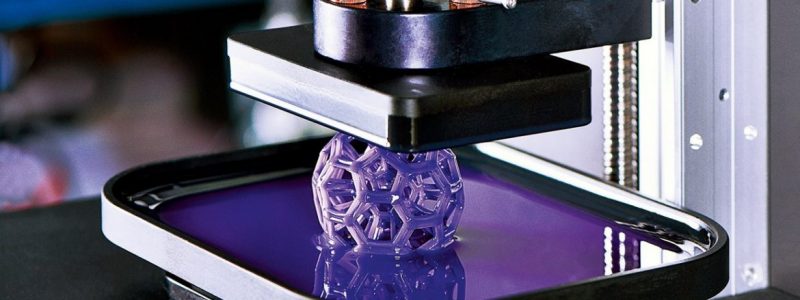During the last few years the 3D printing market has grown at an alarming pace. In 2014, the 3D printing industry was roughly $ 700 million increasing to 8.8 billion U.S dollar industry (1, 2). It is predicted that it will be worth 32.78 billion dollar by 2023, at a compound annual growth rate (CAGR) 25.76% between 2017 and 2023(3). This exponential growth is attributed to factors such as the ease of production of customized products, reduced overall manufacturing costs, and government investments in 3D printing projects and rapid development and innovation of 3D printing technology.
3D printing technology includes both hardware like 3D scanners and 3D printers and 3D modeling software. To use a 3D printer, a computer aided design (CAD) file is created which can be processed by the printer. The CAD file must be in the format that the printer can read. A 3D printer can read the following file formats: Standard Tessellation Language (STL), Virtual Reality Modeling Language (VRML), Additive Manufacturing File Format (AMF) and GCode (4). We shall review some of the 3D printers available in the market.
Stereolithography (SLA)
Stereolithography is one of the oldest methods of 3D printing. This technology was patented by Charles Hull, co-founder of 3D Systems Inc in 1986. SLA printer uses liquid plastic instead of ink and the laser in the printer builds the 3D object layer by layer by hardening the liquid plastic. After the object is printed it is rinsed with a solvent and then placed in an ultraviolet oven to finish processing (5). SLA can create smooth surfaced objects with extreme detail and is popular in industries like jewellery and cosmetic dentistry for creating castable molds (5)
Figure 1: SLA Printer. https://www.linkedin.com/pulse/12-things-consider-when-shopping-3d-printer-franz-grieser/
Digital Light Processing (DLP)
Digital Light Processing like stereolithography 3D Printing process uses liquid photopolymers. The DLP technology, very popular in projectors production, was invented by Larry Hornbeck of Texas Instruments in 1987. DLP works with digital micro mirrors laid out on a semiconductor chip. The technology has applications in movie projectors, cell phones and 3D printing. The light source of DLP is a projector instead of a laser. DLP 3D printers are mainly used in professional environments. This type of 3D printer prints robust pieces with excellent resolution (5).
Figure 2: DLP printer. http://3dprintingfromscratch.com/common/types-of-3d-printers-or-3d-printing-technologies-overview/
Selective Laser Sintering (SLS)
SLS is a printing technique developed by Carl Deckard, a student of Texas University and his professor Joe Beaman in 1980s. SLS is very similar to SLA except that it uses powdered material instead of liquid resin. SLS uses high power laser to print 3D objects. SLS printer can print using a wide variety of materials like nylon, ceramics, glass and metals like aluminum, steel or silver. Therefore, SLS printer is very popular (5).
Figure 3: SLS printer. http://3dprintingfromscratch.com/common/types-of-3d-printers-or-3d-printing-technologies-overview/
Fused deposition modeling (FDM)
FDM technology was created in the 1980s by Scott Crump founder of Stratasys Ltd. There are other similar technologies in the market under other names.
MakerBot has developed a similar technology called Fused Filament Fabrication (FFF).
FDM is the only printing technology that creates parts with production-grade thermoplastics with excellent mechanical, thermal and chemical qualities. The printer heats the thermoplastic till its melting point and extrudes it through the nozzle to build 3D objects layer by layer. This technology is popular in many different industries (5).
The choice of the printer depends on the requirements of the object to be printed. 3D printing technology is evolving rapidly with new innovations and developments emerging at a rapid pace.
Watch out for our next blog post about 3D printing!
Figure 4:FDM printer. http://3dprintingfromscratch.com/common/types-of-3d-printers-or-3d-printing-technologies-overview/
In this survey below, we address the issue of acceptability and demand for medical 3 D printing by the doctors of United Arab Emirates.
Click here to take Survey
Reference
1. Ventola C.L. Medical Applications for 3D Printing: Current and Projected Uses. Pharm. Ther. 2014;39:704–711. [PMC free article] [PubMed]
2. 3D printing market value 2021. 2017. | Forecast. [online] Statista. Available at: https://www+.statista.com/statistics/261693/3d-printing-market-value-forecast/ [Accessed 5 Nov. 2017].
3. Marketsandmarkets.com. (2017). 3D Printing Market worth 32.78 Billion USD by 2023. [online] Available at: http://www.marketsandmarkets.com/PressReleases/3d-printing.asp [Accessed 6 Nov. 2017].
4. 3dprint.nih.gov. (2017). What file formats are used in 3D Printing? | NIH 3D Print Exchange. [online] Available at: https://3dprint.nih.gov/faqs/1781 [Accessed 7 Nov. 2017].
5. 3D Printing from scratch. (2017). Types of 3D printers or 3D printing technologies overview | 3D Printing from scratch. [online] Available at: http://3dprintingfromscratch.com/common/types-of-3d-printers-or-3d-printing-technologies-overview/ [Accessed 14 Nov. 2017].
Image credit: iamwire




